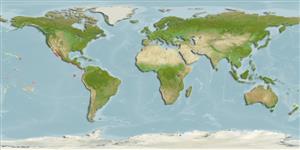分類 / Names
俗名 | 同種異名 | Catalog of Fishes(屬, 種) | ITIS | CoL | WoRMS | Cloffa
Teleostei >
Blenniiformes (Blennies) >
Blenniidae (Combtooth blennies) > Blenniinae
Etymology: Plagiotremus: Greek, plagios = oblique + Greek, trema = hole (Ref. 45335).
More on authors: Jordan & Bollman.
Environment: milieu / climate zone / depth range / distribution range
生態學
海洋 礁區魚類; 深度上下限 2 - 23 m (Ref. 5227).
Eastern Pacific: Gulf of California to Peru, including the Galapagos Islands (Ref. 5227).
大小 / 重量 / 年齡
Maturity: Lm ? range ? - ? cm
Max length : 10.0 cm TL 雄魚/尚未辨別雌雄; (Ref. 11482)
Adults live in empty tube-worm snail shells, often extending the head from the opening. They feed by joining loose groups of look-alike rainbow wrasse and darting out to nip at nearby fish, taking mucus and perhaps small bits of flesh (Ref. 5227). The skin of larger fishes is the mainstay of the diet, although they are also known to eat eggs (Ref. 28023). Oviparous (Ref. 205). Eggs are attached to the walls of the parent's shelter and are brooded by the male parent (Ref. 56053). Larvae are planktonic, often found in shallow, coastal waters (Ref. 94114).
Life cycle and mating behavior
Maturities | 繁殖 | Spawnings | Egg(s) | Fecundities | 仔魚
Oviparous, distinct pairing (Ref. 205). Males guard the eggs until they hatch (Ref. 56053).
Allen, G.R. and D.R. Robertson, 1994. Fishes of the tropical eastern Pacific. University of Hawaii Press, Honolulu. 332 p. (Ref. 11482)
人類使用
工具
特別的報告
下載 XML
網路資源
Estimates based on models
Preferred temperature (Ref.
123201): 22.5 - 29.1, mean 27.1 °C (based on 214 cells).
Phylogenetic diversity index (Ref.
82804): PD
50 = 0.5005 [Uniqueness, from 0.5 = low to 2.0 = high].
Bayesian length-weight: a=0.00562 (0.00258 - 0.01228), b=3.06 (2.87 - 3.25), in cm total length, based on LWR estimates for this (Sub)family-body shape (Ref.
93245).
營養階層 (Ref.
69278): 4.4 ±0.78 se; based on food items.
回復力 (Ref.
120179): 高度, 族群倍增時間少於 15個月 (Preliminary K or Fecundity.).
Fishing Vulnerability (Ref.
59153): Low vulnerability (10 of 100).
Nutrients (Ref.
124155): Calcium = 128 [65, 229] mg/100g; Iron = 0.812 [0.458, 1.384] mg/100g; Protein = 18.6 [17.5, 19.7] %; Omega3 = 0.112 [0.060, 0.208] g/100g; Selenium = 21.2 [10.0, 49.6] μg/100g; VitaminA = 264 [93, 733] μg/100g; Zinc = 1.46 [0.93, 2.17] mg/100g (wet weight);
